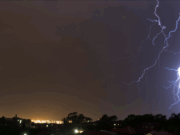A combination of runway lighting issues and an unusual runway entry contributed to a Boeing 787 flight crew’s failure to identify the beginning of Gatwick Airport’s Runway 26R and the resulting takeoff from the displaced threshold rather than the beginning of the runway, the U.K. Air Accidents Investigation Branch (AAIB) says.
No one was injured in the March 28 event, and the 787 was not damaged, but the airplane’s performance did not meet regulatory requirements for either stopping the takeoff roll or continuing in case an engine failed near V1, the AAIB said in its report on the matter, released Thursday. “The risks in both cases were significant to the aircraft and its occupants,” the report said.
V1 is defined in regulations as “the maximum speed in the takeoff at which the pilot must take the first action (e.g., apply brakes, reduce thrust, deploy speed brakes) to stop the airplane within the accelerate-stop distance” and also as “the minimum speed in the takeoff, following a failure of the critical engine at VEF, at which the pilot can continue the takeoff and achieve the required height above the takeoff surface within the takeoff distance.” VEF is the speed at which the critical engine is assumed during performance certification to fail during takeoff.
The AAIB report said that the 787 was scheduled to take off at 2130 local time from Gatwick for Buenos Aires, Argentina.
“The crew elected to perform a rolling takeoff,” the report said. “The tower controller noted that the aircraft did not appear to put on power or accelerate until at the Runway 26R landing threshold. … The crew later recalled that there was not much runway remaining at liftoff.”
The report noted that the airplane entered the runway from Taxiway AN, which led straight to the runway, without the typical turn. A white line marked the start of the runway, but there were no edge lights or centerline lights for the first 417 m (1,368 ft); then, at the displaced threshold, the lights began, the report said. The configuration complies with specifications, the document added.
Beginning the takeoff roll at the displaced threshold decreased the distance available for takeoff by 417 m and reduced the accelerate stop distance available to 2,156 m (7,074 ft) — less than the 2,564 m (8,412 ft) required, the report said.
At least four similar incidents were reported between September 2017 and March 28, 2018, the AAIB report said, noting the “potentially significant hazard to operations.” In recognition of the problem, Gatwick has taken several actions to improve crew awareness of the location of the beginning of the runway, including a Notice to Airmen that describes the correct position for the Runway 26R takeoff roll to begin.


